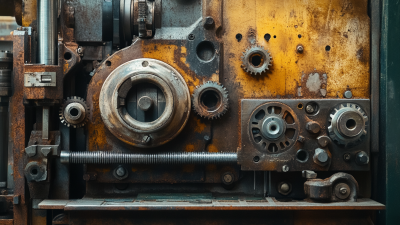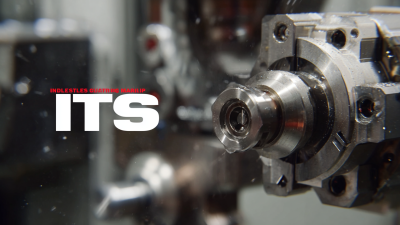Unlocking Precision: The Future of Custom Parts Manufacturing in Innovative Sectors
The landscape of Custom Parts Manufacturing is undergoing a transformative evolution, driven by rapid advancements in technology and the increasing demand for personalized solutions across various sectors. According to a report by the Wohlers Associates, the global 3D printing market is anticipated to reach $50.1 billion by 2025, reflecting a significant shift towards customized production methodologies that enhance precision and efficiency. As industries ranging from aerospace to healthcare prioritize tailored components to meet specific requirements, the integration of innovative manufacturing techniques is not just beneficial but essential.

This growing emphasis on customization is further supported by a McKinsey & Company analysis, highlighting that firms that incorporate advanced manufacturing strategies can experience cost reductions of up to 20% while improving lead times. As we delve into the future of Custom Parts Manufacturing, it is crucial to explore how these innovations can unlock new opportunities and redefine standards across innovative sectors.
Exploring the Role of Digital Technologies in Custom Parts Manufacturing
The integration of digital technologies is revolutionizing custom parts manufacturing, allowing industries to achieve unprecedented levels of precision and efficiency. According to a recent report from McKinsey & Company, companies that adopt advanced manufacturing technologies can boost productivity by up to 20-30%. This shift towards digitalization is particularly significant in innovative sectors such as aerospace and automotive, where the demand for custom components is increasingly driven by complex designs and regulatory requirements.

Additionally, the use of technologies such as 3D printing and automation has substantially reduced lead times and costs associated with custom parts manufacturing. A study by Deloitte forecasts that 3D printing alone could change the competitive landscape, with its market expected to grow to $35.6 billion by 2025. By leveraging these advanced tools, manufacturers can not only streamline their processes but also enhance product customization capabilities, thus meeting the specific needs of clients while maintaining high quality and performance standards. As the industry continues to embrace these digital advancements, the future of custom parts manufacturing looks promising, characterized by agility and innovation.
Innovative Materials: Shaping the Future of Custom Components
In the rapidly evolving landscape of custom parts manufacturing, innovative materials are playing a crucial role in shaping the future of custom components. The integration of advanced materials, such as carbon composites and bio-inspired polymers, is revolutionizing the design and functionality of components across various sectors. These materials not only enhance performance but also allow for greater design freedom, enabling engineers and designers to create parts that were previously deemed impossible with traditional manufacturing methods.
Furthermore, the adoption of additive manufacturing technologies, such as 3D printing, complements the use of innovative materials by allowing for on-demand production and rapid prototyping. This synergy between materials and manufacturing techniques fosters a new era of customization, where components can be tailored precisely to meet the unique requirements of specific applications. Industries ranging from aerospace to healthcare are witnessing the transformative effects of these advancements, as they strive for higher efficiency, reduced weight, and improved durability in their custom components.
Unlocking Precision: The Future of Custom Parts Manufacturing in Innovative Sectors - Innovative Materials: Shaping the Future of Custom Components
| Material Type | Applications | Properties | Advantages | Market Trends |
|---|---|---|---|---|
| Carbon Fiber Reinforced Polymers | Aerospace, Automotive | High strength, Lightweight | Enhanced performance, Fuel efficiency | Growing demand in lightweight applications |
| Titanium Alloys | Medical Implants, Aerospace | Corrosion resistance, Strength | Biocompatibility, Durability | Increasing adoption in medical applications |
| Bio-based Plastics | Consumer Goods, Packaging | Renewable content, Biodegradability | Sustainability, Reduced environmental impact | Rising interest in eco-friendly products |
| Lightweight Alloys | Automotive, Marine | High strength-to-weight ratio, Durability | Improved fuel economy, Enhanced performance | Increased use in electric vehicles |
| Nanomaterials | Electronics, Coatings | Superior strength, Conductivity | Enhanced performance, Lightweight | Rapidly growing sector in technology |
Case Studies: Success Stories in Custom Parts Across Various Industries
Custom parts manufacturing is transforming industries by tailoring solutions to meet specific needs. In the aerospace sector, for example, companies such as Boeing are leveraging 3D printing technology to create lightweight components that enhance fuel efficiency. This approach not only reduces material waste but also significantly lowers production times, showcasing a shift toward on-demand manufacturing that prioritizes both precision and sustainability.
Another compelling case can be found in the automotive industry, where Tesla utilizes advanced custom part production to streamline their assembly processes. By implementing innovative methods like additive manufacturing for unique components, Tesla can quickly adapt to changing design requirements and reduce lead times. This flexibility enables them to maintain a competitive edge while ensuring high-quality standards, exemplifying how custom parts can drive efficiency and innovation in fast-paced markets. These success stories highlight the expansive potential of custom manufacturing across various sectors, paving the way for further advancements in technology and design.
Unlocking Precision: Custom Parts Manufacturing in Various Industries
Strategies for Enhancing Precision in Custom Manufacturing Processes
In custom parts manufacturing, enhancing precision is paramount for meeting the demands of innovative sectors. Strategies that leverage advanced technologies such as AI and digital twins are paving the way for improved accuracy in production processes. By creating a digital twin of the manufacturing setup, companies can ensure that their virtual operations reflect real-world conditions, reducing errors and preventing potential collisions during machining.
Tips: Consider investing in CAM software that integrates seamlessly with digital twin technologies to maximize precision in your operations. Regularly training staff on new digital tools can also enhance the overall efficiency of your manufacturing processes.
Another angle to explore is the role of automation in maintaining manufacturing quality. As industries increasingly rely on lean methodologies, automation offers the ability to consistently deliver high-quality parts while minimizing human error. This is especially crucial in sectors like aerospace and defense, where the costly repercussions of mistakes can be significant.
Tips: Regularly assess and update your automation technologies to keep up with industry standards. Performing routine quality checks can help in identifying areas where precision can be improved, ensuring a smooth production line.
The Impact of AI and Automation on Custom Parts Production Efficiency
The future of custom parts manufacturing is being transformed by the integration of
AI and automation, significantly enhancing production efficiency across various industries.
The global woodworking machinery market is projected to reach $40.07 billion by 2025 and expand to $75.94 billion by 2033,
reflecting a robust growth rate of 6.74%. This surge indicates a strong demand for advanced
manufacturing technologies that can accommodate customized production at scale.
For instance, military investments in 3D printing technology emphasize the critical role of rapid, on-demand manufacturing capabilities.
These innovations not only boost operational effectiveness but also ensure that troops are well-equipped during humanitarian missions and combat situations.
According to forecasts, the computer-aided manufacturing (CAM) market alone is expected to reach $6.567 billion by 2033,
growing from $3.394 billion in 2025, with a steady compound annual growth rate of 8.6%.
Tips: Implementing AI-driven automation in small factories can drive efficiency and precision.
Collaborating with flexible automation systems can help manufacturers securely win custom orders in competitive markets.
As industries increasingly embrace intelligent technologies, it becomes vital for businesses to invest in smart manufacturing solutions
to stay ahead of the curve.

Related Posts
-

Maximizing Your Investment in Machine Shop Tools Through Effective Maintenance Strategies
-

7 Innovative Approaches to Custom Parts Manufacturing for Your Business Success
-

Trusted Quality Indexable Tool Repair Made in China for Global Sharing
-

5 Essential Tips for Global Buyers: Maximizing ROI with Indexable Tooling in Manufacturing
-

What is Indexable Tooling and How It Revolutionizes Modern Machining?
-

How to Navigate Global Import and Export Certifications for the Best Carbide Cutters

